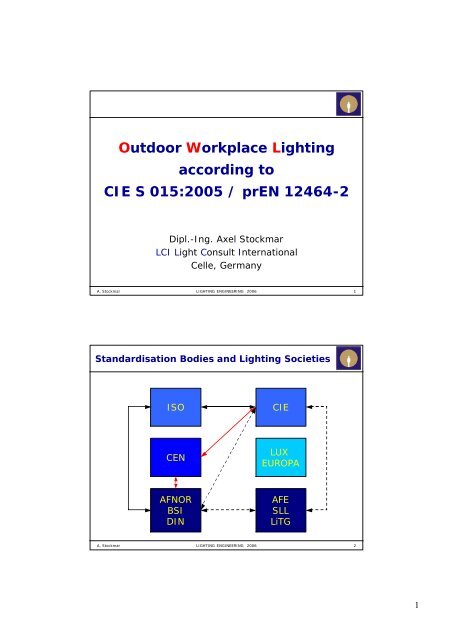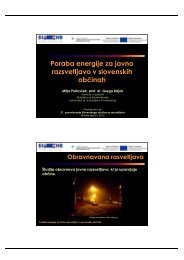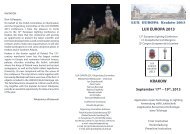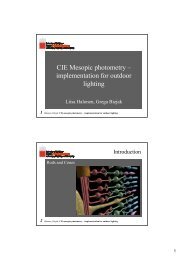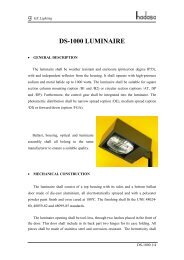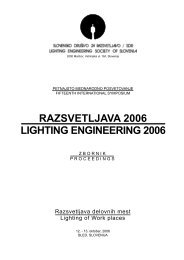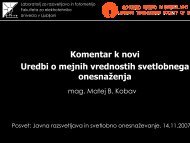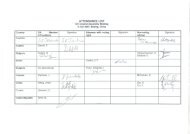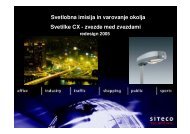Outdoor Workplace Lighting according to CIE S 015:2005 ... - SDR
Outdoor Workplace Lighting according to CIE S 015:2005 ... - SDR
Outdoor Workplace Lighting according to CIE S 015:2005 ... - SDR
Create successful ePaper yourself
Turn your PDF publications into a flip-book with our unique Google optimized e-Paper software.
<strong>Outdoor</strong> <strong>Workplace</strong> <strong>Lighting</strong><br />
<strong>according</strong> <strong>to</strong><br />
<strong>CIE</strong> S <strong>015</strong>:<strong>2005</strong> / prEN 12464-2<br />
Dipl.-Ing. Axel S<strong>to</strong>ckmar<br />
LCI Light Consult International<br />
Celle, Germany<br />
A. S<strong>to</strong>ckmar LIGHTING ENGINEERING 2006 1<br />
Standardisation Bodies and <strong>Lighting</strong> Societies<br />
ISO<br />
<strong>CIE</strong><br />
CEN<br />
LUX<br />
EUROPA<br />
AFNOR<br />
BSI<br />
DIN<br />
AFE<br />
SLL<br />
LiTG<br />
A. S<strong>to</strong>ckmar LIGHTING ENGINEERING 2006 2<br />
1
The current seven <strong>CIE</strong> Divisions (2006)<br />
• Div. I<br />
• Div. II<br />
• Div. III<br />
• Div. IV<br />
• Div. V<br />
• Div. VI<br />
Vision & Colour<br />
Physical Measurement of Light and<br />
Radiation<br />
Interior Environment and <strong>Lighting</strong><br />
Design<br />
<strong>Lighting</strong> and Signalling for Transport<br />
Exterior and other <strong>Lighting</strong><br />
Applications<br />
Pho<strong>to</strong>-biology and Pho<strong>to</strong>-chemistry<br />
• Div. VIII Image Technology<br />
A. S<strong>to</strong>ckmar LIGHTING ENGINEERING 2006 3<br />
CEN TC 169 Light and <strong>Lighting</strong> (2006)<br />
• WG1 Basic Terms and Criteria (EN 12665)<br />
• WG2 <strong>Lighting</strong> of Work Places (EN 12464)<br />
• WG3 Emergency <strong>Lighting</strong> (EN 1838)<br />
• WG4 Sports <strong>Lighting</strong> (EN 12193)<br />
• WG5 Road <strong>Lighting</strong> (EN 13201)<br />
• WG6 Tunnel <strong>Lighting</strong> (CR 14380)<br />
• WG7 Pho<strong>to</strong>metry (EN 13032)<br />
• WG8 Pho<strong>to</strong>biology (EN 14255)<br />
• WG9 Energy Performance of Buildings -<br />
Energy Requirements for <strong>Lighting</strong> (EN 14193)<br />
A. S<strong>to</strong>ckmar LIGHTING ENGINEERING 2006 4<br />
2
Relevant <strong>CIE</strong> Publications for <strong>CIE</strong> S <strong>015</strong>:<strong>2005</strong><br />
• <strong>CIE</strong> 112-1994 Glare Evaluation System for Use<br />
within <strong>Outdoor</strong> Sports and Area <strong>Lighting</strong><br />
• <strong>CIE</strong> 115-1995 Recommendations for the <strong>Lighting</strong><br />
of Roads for Mo<strong>to</strong>r and Pedestrian Traffic<br />
• <strong>CIE</strong> 129-1998 Guide for <strong>Lighting</strong> Exterior Work<br />
Places<br />
• <strong>CIE</strong> 140-2000 Road <strong>Lighting</strong> Calculations<br />
• <strong>CIE</strong> 150-2003 Guide on the Limitations of the<br />
Effects of Obtrusive Light from <strong>Outdoor</strong> <strong>Lighting</strong><br />
Installations<br />
• <strong>CIE</strong> 154-2003 Maintenance of <strong>Outdoor</strong> <strong>Lighting</strong><br />
Systems<br />
A. S<strong>to</strong>ckmar LIGHTING ENGINEERING 2006 5<br />
Relevant Publication for prEN 12464-2 (2003)<br />
• A.F.E. „Recommandations relatives à<br />
l´éclairage des voies publiques“<br />
• CIBSE LG6 „The <strong>Outdoor</strong> Environment”<br />
• DIN 5035 „Beleuchtung mit künstlichem Licht“<br />
• ICAO „International Standards and<br />
Recommended Practices Aerodromes”<br />
• DB 954.9103 „Beleuchtungsanlagen im<br />
gleisnahen und/oder sicherheitsrelevanten<br />
Bereich“<br />
etc.<br />
A. S<strong>to</strong>ckmar LIGHTING ENGINEERING 2006 6<br />
3
<strong>Lighting</strong> Design Criteria (<strong>CIE</strong> S <strong>015</strong>:<strong>2005</strong>)<br />
• Luminance distribution (description only)<br />
• Illuminance levels (maintained values),<br />
uniformities, and diversities<br />
(for task areas and surroundings)<br />
• Limitation of glare<br />
(for train drivers and passengers)<br />
• Directionality of light (description only)<br />
• Colour appearance and colour rendering<br />
• Avoidance of flicker and stroboscopic effects<br />
(description only)<br />
• Limitation of obtrusive light<br />
A. S<strong>to</strong>ckmar LIGHTING ENGINEERING 2006 7<br />
Illuminances, <strong>CIE</strong> S <strong>015</strong>:<strong>2005</strong> (I)<br />
• All values of illuminances in this standard are<br />
maintained illuminances over the task area<br />
on the reference surface which may be<br />
horizontal, vertical or inclined.<br />
• The task area is defined as the partial area in<br />
the work place in which the visual task is<br />
carried out.<br />
• For places where size and/or location of the<br />
task area are unknown, the area where the<br />
task may occur is the task area.<br />
A. S<strong>to</strong>ckmar LIGHTING ENGINEERING 2006 8<br />
4
Illuminances, <strong>CIE</strong> S <strong>015</strong>:<strong>2005</strong> (II)<br />
• The maintained illuminance of the<br />
surrounding area shall be related <strong>to</strong> the<br />
maintained illuminance of the task area and<br />
should provide a well-balanced luminance<br />
distribution in the field of view.<br />
• The surrounding area is regarded as a strip<br />
surrounding the task area in the field of<br />
view; the width of this strip should be at<br />
least 2 m.<br />
A. S<strong>to</strong>ckmar LIGHTING ENGINEERING 2006 9<br />
Relationship of maintained illuminances of<br />
surrounding areas <strong>to</strong> task areas<br />
Task illuminance<br />
≥ 500 lx<br />
300 lx<br />
200 lx<br />
150 lx<br />
50 lx ≤ E m ≤ 100 lx<br />
< 50 lx<br />
Illuminance of<br />
surrounding areas<br />
100 lx<br />
75 lx<br />
50 lx<br />
30 lx<br />
20 lx<br />
no specification<br />
Surrounding area is a strip surrounding<br />
the task area within the field of view;<br />
this strip should have a width of at least 2 m.<br />
A. S<strong>to</strong>ckmar LIGHTING ENGINEERING 2006 10<br />
5
Uniformity and Diversity (<strong>CIE</strong> S <strong>015</strong>:<strong>2005</strong>)<br />
• Illuminance uniformity U o is defined as the ratio<br />
of minimum <strong>to</strong> average illuminance on a surface.<br />
• The uniformity of the task area shall not be less<br />
than the values given in table 5 of <strong>CIE</strong> S <strong>015</strong>:<strong>2005</strong>,<br />
the uniformity of the surroundings shall not be less<br />
than 0.10.<br />
• Illuminance diversity U d is defined as the ratio of<br />
minimum <strong>to</strong> maximum illuminance on a surface.<br />
• The diversity is an important quality criterion for<br />
railway lighting, and shall not be less than the<br />
values specified in table 5 of <strong>CIE</strong> S <strong>015</strong>:<strong>2005</strong>.<br />
A. S<strong>to</strong>ckmar LIGHTING ENGINEERING 2006 11<br />
Illuminance Grid Size (<strong>CIE</strong> S <strong>015</strong>:<strong>2005</strong>)<br />
Maximum grid size (A. S<strong>to</strong>ckmar):<br />
p = 0.2 • 5 log d<br />
p ... grid cell size (m), p max = 10 m<br />
d ... longer dimension of area (m) if the ratio of<br />
the longer <strong>to</strong> the shorter side is less than 2,<br />
otherwise<br />
d ... shorter dimension of area (m)<br />
A. S<strong>to</strong>ckmar LIGHTING ENGINEERING 2006 12<br />
6
Illuminance Grid Size (<strong>CIE</strong> S <strong>015</strong>:<strong>2005</strong>)<br />
Illuminance grid size as function of area dimension,<br />
example: d = 48 m, p = 3 m, n = 16<br />
A. S<strong>to</strong>ckmar LIGHTING ENGINEERING 2006 13<br />
Maintained Illuminance - Maintenance Fac<strong>to</strong>r,<br />
<strong>CIE</strong> S <strong>015</strong>:<strong>2005</strong> (I)<br />
• The maintained illuminance is defined as<br />
the value below which the illuminance on a<br />
specified surface is not allowed <strong>to</strong> fall<br />
• The lighting scheme should be designed with a<br />
maintenance fac<strong>to</strong>r calculated for the<br />
selected lighting equipment, space<br />
environment and specified maintenance<br />
schedule<br />
• The maintenance fac<strong>to</strong>r depends on the<br />
maintenance characteristics of the lamp<br />
and control gear, the luminaire, the<br />
environment and the maintenance programme<br />
A. S<strong>to</strong>ckmar LIGHTING ENGINEERING 2006 14<br />
7
Maintained Illuminance - Maintenance Fac<strong>to</strong>r,<br />
<strong>CIE</strong> S <strong>015</strong>:<strong>2005</strong> (II)<br />
According <strong>to</strong> <strong>CIE</strong> Publication 154-2003<br />
„The Maintenance of <strong>Outdoor</strong> <strong>Lighting</strong> Systems“<br />
The maintenance fac<strong>to</strong>r is defined as the ratio<br />
of the luminance / illuminance produced by the<br />
lighting system after a certain period <strong>to</strong> the<br />
luminance / illuminance produced by the same<br />
system when new.<br />
A. S<strong>to</strong>ckmar LIGHTING ENGINEERING 2006 15<br />
Determination of Maintenance Fac<strong>to</strong>r (I)<br />
MF = LLMF • LSF • LMF ( • SMF )<br />
MF ........ Maintenance Fac<strong>to</strong>r<br />
LLMF ..... Lamp Lumen Maintenance Fac<strong>to</strong>r<br />
LSF ....... Lamp Survival Fac<strong>to</strong>r<br />
LMF ....... Luminaire Maintenance Fac<strong>to</strong>r<br />
SMF ....... Surface Maintenance Fac<strong>to</strong>r<br />
A. S<strong>to</strong>ckmar LIGHTING ENGINEERING 2006 16<br />
8
Determination of Maintenance Fac<strong>to</strong>r (II)<br />
Influencing fac<strong>to</strong>rs (positive)<br />
• Application of lamps with modest luminous flux<br />
depreciation (dependent on hours of operation)<br />
• Application of luminaires with modest tendency <strong>to</strong><br />
accumulate dirt<br />
• (Application of electronic control gear)<br />
• (Few annual lamp operating hours)<br />
• Few switching cycles<br />
• Short cleaning and/or maintenance periods, spot<br />
and group replacement of lamps<br />
• Clean environment (airborne dirt)<br />
• Modest tendency <strong>to</strong> accumulate dirt and/or modest<br />
degradation of reflecting surfaces<br />
A. S<strong>to</strong>ckmar LIGHTING ENGINEERING 2006 17<br />
Determination of Maintenance Fac<strong>to</strong>r (III)<br />
Influencing fac<strong>to</strong>rs (negative)<br />
• Application of lamps with high luminous flux<br />
depreciation (dependent on hours of operation)<br />
• Application of luminaires with strong tendency <strong>to</strong><br />
accumulate dirt<br />
• Application of poor quality control gear<br />
• Many annual lamp operating hours<br />
• (Numerous switching cycles)<br />
• Long cleaning and/or maintenance periods,<br />
group replacement of lamps only<br />
• Polluted environment (airborne dirt)<br />
• Strong tendency <strong>to</strong> accumulate dirt and/or high<br />
degradation of reflecting surfaces<br />
A. S<strong>to</strong>ckmar LIGHTING ENGINEERING 2006 18<br />
9
Colour Appearance and Colour Rendering,<br />
<strong>CIE</strong> S <strong>015</strong>:<strong>2005</strong> (I)<br />
Colour appearance<br />
Warm<br />
Intermediate<br />
Cool<br />
Correlated colour<br />
temperature T cp<br />
below 3300 K<br />
3300 K <strong>to</strong> 5300 K<br />
above 5300 K<br />
Minimum values of the general colour rendering index for<br />
distinct areas, tasks or activities are given in the schedule of<br />
lighting requirements (e.g. R a >=20, also >=40 or >=60)<br />
A. S<strong>to</strong>ckmar LIGHTING ENGINEERING 2006 19<br />
Colour Appearance and Colour Rendering,<br />
<strong>CIE</strong> S <strong>015</strong>:<strong>2005</strong> (II)<br />
<strong>CIE</strong> test colours for the evaluation of the<br />
general colour rendering index R a (1-8) and the<br />
special colour rendering indices (8-14)<br />
A. S<strong>to</strong>ckmar LIGHTING ENGINEERING 2006 20<br />
10
<strong>CIE</strong> Glare Rating Method (I)<br />
Calculation formula <strong>according</strong> <strong>to</strong> <strong>CIE</strong> 112-1994<br />
„Glare Evaluation System for Use within <strong>Outdoor</strong><br />
Sports and Area <strong>Lighting</strong>“:<br />
GR = 27 + 24 • log ( L vl / L ve<br />
0.9<br />
)<br />
L vl ... Veiling luminance caused by the lighting<br />
installation<br />
L ve ... Equivalent veiling luminance of the<br />
environment<br />
A. S<strong>to</strong>ckmar LIGHTING ENGINEERING 2006 21<br />
<strong>CIE</strong> Glare Rating Method (II)<br />
Observers at grid positions at 45° intervals<br />
radially about the grid points (<strong>CIE</strong> S<strong>015</strong>:<strong>2005</strong>)<br />
A. S<strong>to</strong>ckmar LIGHTING ENGINEERING 2006 22<br />
11
<strong>CIE</strong> Glare Rating Method (III)<br />
1)<br />
2)<br />
Application dependent observer positions and<br />
viewing directions every 15° from -30° <strong>to</strong> +30°:<br />
1) roof of covered platform, 2) open platform<br />
A. S<strong>to</strong>ckmar LIGHTING ENGINEERING 2006 23<br />
Limitation of Obtrusive Light,<br />
Definitions as given in <strong>CIE</strong> 150:2003<br />
• Obtrusive Light: Light, outside the area <strong>to</strong> be<br />
lit, which, because of quantitative, directional<br />
or spectral attributes in a given context,<br />
gives rise <strong>to</strong> annoyance, discomfort,<br />
distraction or a reduction in the ability <strong>to</strong> see<br />
essential information<br />
• Curfew: The time after which stricter<br />
requirements (for the control of obtrusive<br />
light) will apply; often a condition of use of<br />
lighting applied by a government controlling<br />
authority, e.g. the local government<br />
A. S<strong>to</strong>ckmar LIGHTING ENGINEERING 2006 24<br />
12
Limitation of Obtrusive Light,<br />
Environmental <strong>Lighting</strong> Zones<br />
Zone<br />
Surrounding<br />
<strong>Lighting</strong><br />
Environment<br />
Examples<br />
E1<br />
Natural<br />
Intrinsically dark<br />
National parks,<br />
protected sides<br />
E2<br />
Rural<br />
Low district<br />
brightness<br />
Industrial or residential<br />
rural areas<br />
E3<br />
E4<br />
Suburban<br />
Urban<br />
Medium district<br />
brightness<br />
High district<br />
brightness<br />
Industrial or residential<br />
suburbs<br />
Town centres,<br />
commercial areas<br />
Problem: Which zone is <strong>to</strong> be applied if location of<br />
interest for the assessment differs from<br />
zone where the lighting is installed ?<br />
A. S<strong>to</strong>ckmar LIGHTING ENGINEERING 2006 25<br />
Limits of Obtrusive Light for <strong>Outdoor</strong> <strong>Lighting</strong>,<br />
<strong>CIE</strong> S <strong>015</strong>:<strong>2005</strong><br />
• Maximum vertical illuminance (E v ) on<br />
properties (for pre- and post-curfew hours)<br />
• Maximum luminous intensities of individual<br />
light sources in<strong>to</strong> potentially obtrusive<br />
directions (for pre- and post-curfew hours)<br />
• Maximum upward light ratios (ULR)<br />
• Maximum average luminances of building<br />
facades (L b ) and signs (L s )<br />
• Maximum threshold increments (TI) for users<br />
of nearby roads<br />
A. S<strong>to</strong>ckmar LIGHTING ENGINEERING 2006 26<br />
13
<strong>CIE</strong> 150:2003 Methodology(I),<br />
Maximum Obtrusive Light permitted<br />
Zone<br />
Illuminance on<br />
Properties<br />
Postcurfew<br />
Precurfew<br />
E v in lx<br />
Precurfew<br />
Luminaire<br />
Intensity<br />
Postcurfew<br />
I in cd<br />
Upward<br />
Light<br />
Ratio<br />
ULR<br />
in %<br />
Luminance<br />
L b in<br />
cd/m 2<br />
Building<br />
facade<br />
L s in<br />
cd/m 2<br />
Signs<br />
E1<br />
2<br />
0<br />
2500<br />
0<br />
0<br />
0<br />
50<br />
E2<br />
5<br />
1<br />
7500<br />
500<br />
5<br />
5<br />
400<br />
E3<br />
10<br />
2<br />
10000<br />
1000<br />
15<br />
10<br />
800<br />
E4<br />
25<br />
5<br />
25000<br />
2500<br />
25<br />
15<br />
1000<br />
Problem: Values are given for the summation of all contributing<br />
lighting installations. How <strong>to</strong> apply these values if<br />
lighting systems are installed one after each other ?<br />
A. S<strong>to</strong>ckmar LIGHTING ENGINEERING 2006 27<br />
<strong>CIE</strong> 150:2003 Methodology (II),<br />
Maximum Values of Threshold Increments<br />
Road classification<br />
No road<br />
lighting<br />
M5<br />
M4/M3<br />
M2/M1<br />
Threshold<br />
increment<br />
(TI)<br />
15%<br />
based on<br />
adaptation<br />
luminance<br />
of<br />
0.1 cd/m 2<br />
15%<br />
based on<br />
adaptation<br />
luminance<br />
of<br />
1.0 cd/m 2<br />
15%<br />
based on<br />
adaptation<br />
luminance<br />
of<br />
2.0 cd/m 2<br />
15%<br />
based on<br />
adaptation<br />
luminance<br />
of<br />
5.0 cd/m 2<br />
Problems: Road classification is not in line with EN 13201-2.<br />
<strong>Lighting</strong> installations could increase veiling luminance<br />
at the observer‘s eye without necessarily increasing<br />
the average luminance in the field of view.<br />
A. S<strong>to</strong>ckmar LIGHTING ENGINEERING 2006 28<br />
14
<strong>Lighting</strong> Requirements for Areas, Tasks and<br />
Activities, <strong>CIE</strong> S <strong>015</strong>:2003<br />
• General circulation areas at outdoor work places<br />
• Airports<br />
• Building sites<br />
• Canals, locks and harbours<br />
• Farms<br />
• Fuel filling stations<br />
• Industrial sites and s<strong>to</strong>rage areas<br />
• Off-shore gas and oil structures<br />
• Parking areas<br />
• Petrochemical and other hazardous industries<br />
• Power, electricity, gas and heat plants<br />
• Railways and tramways (5.12)<br />
• Saw mills<br />
• Shipyards and docks<br />
• Water and sewage plants<br />
A. S<strong>to</strong>ckmar LIGHTING ENGINEERING 2006 29<br />
<strong>Lighting</strong> Requirements for Areas, Tasks and<br />
Activities I (table 5.12 of <strong>CIE</strong> S <strong>015</strong>:<strong>2005</strong>)<br />
Avoid glare for vehicle driver, special attention<br />
is <strong>to</strong> be paid <strong>to</strong> the edge of the platform<br />
A. S<strong>to</strong>ckmar LIGHTING ENGINEERING 2006 30<br />
15
<strong>Lighting</strong> Requirements for Areas, Tasks and<br />
Activities II (table 5.12 of <strong>CIE</strong> S <strong>015</strong>:<strong>2005</strong>)<br />
Avoid glare for vehicle driver, special attention<br />
is <strong>to</strong> be paid <strong>to</strong> the edge of the platform<br />
A. S<strong>to</strong>ckmar LIGHTING ENGINEERING 2006 31<br />
Passenger Volume Dependent <strong>Lighting</strong><br />
Requirements for Platforms (<strong>CIE</strong> S <strong>015</strong>:<strong>2005</strong>)<br />
Type of Platform<br />
E m<br />
U o<br />
U d<br />
GR L<br />
Open platforms, rural and local trains, small<br />
number of passengers<br />
15 lx<br />
0.25<br />
0.125<br />
50<br />
Open platforms, suburban and regional<br />
trains with large number of passengers or<br />
inter-city services with small number of<br />
passengers<br />
20 lx<br />
0.40<br />
0.20<br />
45<br />
Open platforms, inter-city services<br />
50 lx<br />
0.40<br />
0.20<br />
45<br />
Covered platforms, suburban or regional<br />
trains or inter-city services with small<br />
number of passengers<br />
50 lx<br />
0.40<br />
0.20<br />
45<br />
Covered platforms, inter-city services<br />
100 lx<br />
0.50<br />
0.33<br />
45<br />
Illuminance level as function of passenger volume<br />
A. S<strong>to</strong>ckmar LIGHTING ENGINEERING 2006 32<br />
16
<strong>Outdoor</strong> <strong>Workplace</strong> <strong>Lighting</strong><br />
<strong>according</strong> <strong>to</strong><br />
<strong>CIE</strong> S <strong>015</strong>:<strong>2005</strong> / prEN 12464-2<br />
End<br />
A. S<strong>to</strong>ckmar LIGHTING ENGINEERING 2006 33<br />
17


